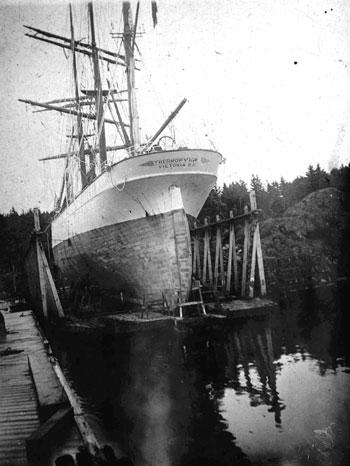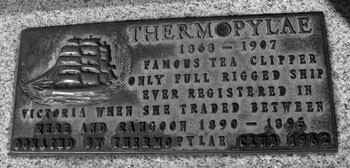Apr
6
By Ted Ross
Then:
 |
| Image A-04172 courtesy of the Royal BC Museum, BC Archives |
From the middle of the 19 century until the opening of the Suez Canal in 1870, sailing vessels, known as Clipper Ships, dominated the ocean trade routes. These beautiful ships carried tea from China and wool from Australia to British ports. They carried English goods to far away lands, returning with valuable cargoes, as quickly as they could. Lumber went around the world on these vessels.
The fleetest of these clippers were built in the shipyards of Aberdeen, Scotland, well up on the coast of the North Sea. The swiftest of them all, Thermopylae, was launched in 1868. She was one of a series of vessels built for White Star Lines by Walter Hood & Co. , and designed by Bernard Weymouth.
The Aberdeen Herald, August 22, 1868, reported, "There was launched, on Wednesday...a composite ship of 1300 tons...christened 'The Thermopylae'. She was built of the most durable materials, and classified in the highest range of character at Lloyds. She is intended for the London and China trade." She was teak above the waterline, and elm below.
Her maiden voyage was to Melbourne, which she made in just 60 days, via Shanghai and Fuzhou, breaking records on each leg of the journey - only steamers had matched her speeds. Her record day's run was 380 statute miles, a feat exceeded by no sailing ship before.
 |
| Image B-06637 courtesy of the Royal BC Museum, BC Archives |
Thermopylae worked in the tea, wool, coal and lumber shipping trade for White Star Lines out of Aberdeen for many years. The Suez Canal, however, had shortened the route to the east for the coalburning steamships which then took much of the clippers' work. Rates dropped and cargoes became more difficult to procure for the wind-driven ships.
By 1890 White Star Lines had sold the ship to The Mount Royal Rice Milling & Manufacturing Co. of Montreal. She was destined to be registered in Victoria, and carry rice from Rangoon to the Company's rice mill on Store Street, present home of Capital Iron. The ship would carry lumber east. The clipper anchored at Royal Roads, off Victoria, for the first time at midnight, June 24, 1891. She carried a cargo of 1,350 tons of rice and a quantity of grass matting. The Daily Colonist, March 26, 1978 noted, "Next day she was towed over to the Outer Wharf and then the crowds came to marvel at the spars and the slenderness of the lines of the bow of the famous ship that was now to call Victoria home."
Crewed with locals experienced in the sealing trade, Thermopylae made several voyages across the Pacific over the next four years. Her crossing times varied from a stormy weather 103 days to a speedy trip of 29 days. In 1893 she was re-rigged to cut her crew size nearly in half. Still, by 1895 she was no longer economically viable to her owners. She carried one final load of lumber, loaded at Port Blakely, Washington, and after a passage of 141 days arrived in Leith, Scotland. There her cargo was discharged and Thermopylae was sold to the Portugese Navy.
Renamed Pedro Nunes, she was used as a school ship for the navy. By 1912 marine surveyors had condemned the vessel. The Portugese eventually decided to scuttle her. Being a sea-faring people, with a proud marine heritage, they fired torpedoes at the ship with colours flying and bands playing on the ships doing the shooting, giving her a proper funeral.
The Daily Colonist, July 29, 1913, reported, "Famous for many years as one of the fastest clipper ships that sailed the high seas Thermopylae was...sunk several months ago off the Tagas. Twenty years ago the Thermopylae plied to Victoria from the Orient in the rice trade."
The ship's remains have been recently located, encased in sand on the ocean-bottom off Lisbon.
Now:
 If you're walking along the Government Street causeway, there are two plaques referring to Victoria's own clipper ship. The plaque seventh in from the south end, placed by Robert Reford Inc., Montreal, Q.C, commemorates Thermopylae’s serviceto their company in the 1890s. A little further north, in the recess behind James Cook's statue, is a plaque placed by the Thermopylae Club in 1962. It commemorates the time when the Thermopylae was based in Victoria and shows all her years of work. There is an engraving of the ship on the plaque, an honour which none of the other plaques have.
If you're walking along the Government Street causeway, there are two plaques referring to Victoria's own clipper ship. The plaque seventh in from the south end, placed by Robert Reford Inc., Montreal, Q.C, commemorates Thermopylae’s serviceto their company in the 1890s. A little further north, in the recess behind James Cook's statue, is a plaque placed by the Thermopylae Club in 1962. It commemorates the time when the Thermopylae was based in Victoria and shows all her years of work. There is an engraving of the ship on the plaque, an honour which none of the other plaques have.
The Thermopylae is truly unique!
Bibliography
The Daily Colonist, "End of Famous Clipper Ship Thermopylae", Tuesday, July 29, 1913; The Daily Colonist, "Thermopylae Victoria's Own Clipper Ship", Arthur Ives, Sunday, October 28, 1979; The Daily Colonist, "Victoria's Own Tall Ship...a legend among those who love to sail", Ursula Jupp, Sunday, March 26, 1978; Harbour Shipping, "Nautical Nostaligia", August 2005; Aberdeen City Council, "Aberdeen Built Ships", 2013; Wikipedia, "Thermopylae (clipper)", 2014.
